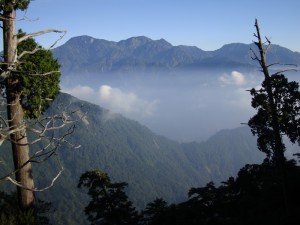
Enjoy a stunning variety of exotic birds in a beautiful landscape with a pleasant climate…
When the Portuguese first arrived in Taiwan, they called it Formosa, meaning the beautiful island. The wonderful scenery is thanks to a spine of forested mountains, which cover almost half of the island, rising to over 13,000 feet! These mountains are carved by deep river valleys and the resulting topography provides a range of habitats which are home to the second highest bird density on earth! The 500 or more species recorded here include 30 endemics with exciting names like Taiwan Hwamei, Styan’s Bulbul, Taiwan Whistling Thrush, Taiwan and Black-necklaced Scimitar Babblers, White-whiskered, Rusty and Rufous-crowned Laughingthrushes, Collared Bush Robin, Steere’s Liocichla, White-eared Sibia and Taiwan Yuhina, plus the stunning Mikado and Swinhoe’s Pheasants and the Taiwan Blue Magpie, which is the national bird of this friendly safe country. Located on the Tropic of Cancer, the island enjoys a pleasant climate in April, ranging from warm to cool according to the altitude, and at this exciting time, the exotic resident birds are joined by thousands of birds from the Asian mainland which is just 62 miles away across the Formosa Strait on the East Asian flyway. So, with all this fantastic scenery and birdlife, along with good food, and an interesting culture, Taiwan has a lot to offer. Throughout a fabulous trip on this amazing bird-rich island we shall be accompanied by Jian Long Wu, one of Taiwan’s most experienced local guides.
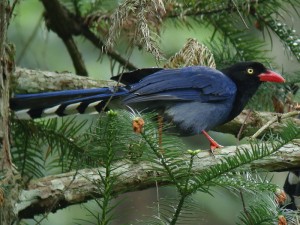 Taiwan Blue Magpie
Taiwan Blue Magpie
Day 1 We depart Birmingham airport on an early evening flight with Turkish Airlines to Istanbul and transfer to a late night onward flight to Taipei. Dinner and overnight in flight.
Day 2 We arrive in Taipei early this evening, where we will be met by our local guide and transferred a short distance to our first hotel which overlooks the bird-rich Daan Forest Park. Dinner and overnight at the Rido Hotel in Taipei.
Day 3 We begin this exciting tour with an exploration of the Xindian and Wulai areas in the northern end of the island, not far from Taipei, where we should find a variety of exotic birds like Eastern Spot-billed Duck, Oriental Pratincole, Red Collared Dove, Japanese White-eye, Eastern Yellow Wagtail, Light-vented Bulbul, Chestnut-cheeked, White-cheeked and Red-billed Starlings and Crested Myna. Dinner and overnight at the Rido Hotel.
Day 4 This morning, we visit the local park and the nearby botanical gardens, both beautiful homes to birds like Malayan Night Heron, Collared Scops Owl, Oriental Turtle Dove, Spotted Dove, Pale Thrush, Black Drongo, Brown Shrike, Grey Treepie, Grey-throated Martin, Rufous-capped Babbler, Black Bulbul and Black-collared and Asian Glossy Starlings plus endemics like Taiwan Barbet, Black-necklaced and Taiwan Scimitar Babblers, Grey-cheeked Fulvetta and the magnificent Taiwan Blue Magpie.
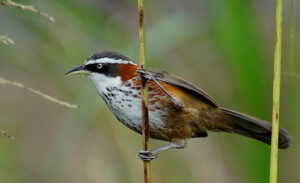 Taiwan Scimitar Babbler
Taiwan Scimitar Babbler
This afternoon we have a two hour train ride down the beautiful east coast through seaside villages to Hualien, where we will be staying at a wonderful guesthouse with a great fourth floor lookout for birding, where sightings have included Crested Goshawk, Blue Rock Thrush, Javan Myna and the endemic and rare Styan’s Bulbul. Dinner and overnight at the Pretty Sun Guesthouse in Hualien.
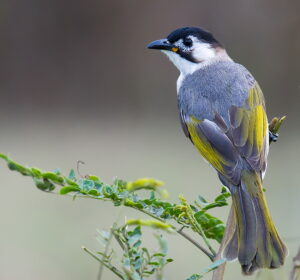 Styan’s Bulbul
Styan’s Bulbul
Day 5 We have a full day to explore Taroko National Park where the spectacular Taroko Gorge, carved by the tumultuous Liwu River, is one of the largest marble canyons in the world! As well as getting to know the geological and cultural wonders here, we can also hope to see Formosan Rock Macaque, Red-bellied Tree Squirrel and birds like Besra, Silver-backed Needletail, Asian House Martin, Brown Dipper, Bronzed Drongo, Plumbeous Redstart, Little Forktail, Green-backed Tit, the aptly named Vivid Niltava and the endemic Taiwan Whistling Thrush and Taiwan Yuhina. Dinner and overnight at the Pretty Sun Guesthouse.
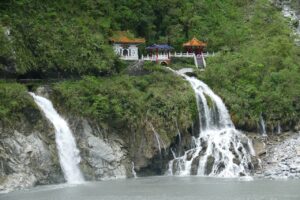 Taroko Gorge
Taroko Gorge
Day 6 This morning, we visit the nearby lovely Liyu Lake where 150 bird species have been recorded including Crested Serpent Eagle, Grey-chinned Minivet, White-bellied Erpornis, Black-naped Monarch, Dusky Fulvetta, Large-billed Crow, the cute Rufous-faced Warbler and the endemic Taiwan Partridge. Later we visit the Hualien Estuary on the lookout for a variety of shorebirds and then take the train back to Taipei for another night at the Rido Hotel.
Day 7 We have a three hour drive from Taipei south to Dasyueshan, with several birding stops along the way, such as at the Xucuogang wetland and Jincheng Lake, on the lookout for waterbirds like Yellow Bittern, Chinese Egret and White-breasted Waterhen amongst others. By late afternoon, we arrive at Dasyueshan Forest Lodge high up in the Dasyueshan National Forest at around 6,800 feet. Dinner and overnight at Dasyueshan Forest Lodge.
Days 8 & 9 We have the luxury of two full days in the renowned Dasyueshan Forest, a birding ‘hotspot’ with a range of habitats from subtropical lowlands to temperate coniferous forest at over 7,500 feet. Lower down we are likely to encounter our first Collared Finchbill as well as birds like Lesser Coucal, Striated Swallow and Lanceolated Warbler. We may also find Grey-capped Pygmy Woodpecker, Bull-headed Shrike, Black-browed Reed Warbler, Middendorf’s Grasshopper Warbler and Dusky and Yellow-browed Warblers. Along the roadsides we can hope for great views of Striated Heron and the endemic Taiwan Bamboo Partridge, and as we get higher, we can also find White-backed and Grey-headed Woodpeckers and Striated Prinia. A major star among stars in this forest is the stunning Swinhoe’s Pheasant and while waiting for one to show we should also enjoy great views of White-tailed Robin and the endemic Steere’s Liocichla and White-eared Sibia, as well as Pallas’s Squirrel.
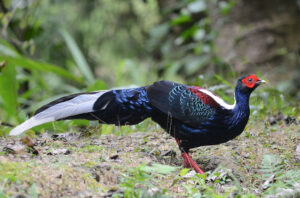 Swinhoe’s Pheasant
Swinhoe’s Pheasant
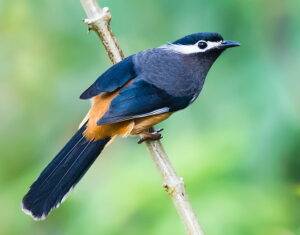 White-eared Sibia
White-eared Sibia
Above our lodge the graceful Mikado Pheasant is a major target and while staking them out along the road, the very confiding endemic White-whiskered Laughingthrush will hopefully pose for us along with Maritime Striped Squirrels. Nearby we will be alert for White-browed and endemic Collared Bush Robins, and as we reach the Hemlock and Dwarf Bamboo forest at the highest points, we may meet the distinctive endemic subspecies of Spotted Nutcracker, as well as Yellow-bellied and Brown-flanked Bush Warblers. Mixed flocks here hold the local crested race of Coal Tit, plus Black-throated Tit, Fire-breasted Flowerpecker and the endemic Yellow Tit, while all this activity often attracts a Collared Owlet. Meanwhile the landscape is breathtaking with distant views of Taiwan’s highest peak, Yushan, at over 13,000 feet. The excellent Pinewoods around our lodge are often the best place for Ashy Wood Pigeon, Brown Bullfinch and the endemic Rufous-crowned Laughingthrush. In the evenings we can search the lodge grounds for Himalayan Owl, Mountain Scops Owl and the charismatic Red-and-white Flying Squirrel, while the mornings can produce several endemics such as Taiwan Barwing, Taiwan Fulvetta, Taiwan Rosefinch and the tiny Taiwan Cupwing and Flamecrest, plus White’s, Dusky, Scaly and Brown-headed Thrushes. Dinners and overnights at Dasyueshan Forest Lodge.
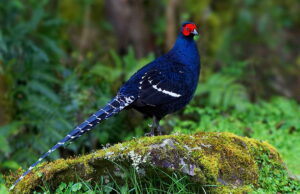 Mikado Pheasant
Mikado Pheasant
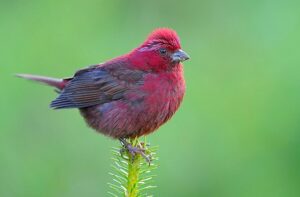 Taiwan Rosefinch
Taiwan Rosefinch
Day 10 From Dasyueshan it is a three hour drive south to the Qingjing Farm area with a stop en route in the Huisun National Forest where the Taiwan Blue Magpie is particularly common. The endemic Rusty Laughingthrush, Chestnut-bellied Tit and Taiwan Hwamei are also possible here. Journey’s end is the Dream Forest Villa in Renai.
Day 11 Today we explore the Hehuanshan Pass along the highest road east of the Himalayas! At over 10,000 feet this is the only place for the endemic subspecies of Alpine Accentor. Dropping down from the alpine areas into woods, we will be on the lookout for birds like Mountain Hawk Eagle, White-bellied Green Pigeon, Oriental Cuckoo, Ferruginous Flycatcher, Golden Parrotbill and the endemic Taiwan Bush Warbler and Taiwan Bullfinch. We also visit the nearby Aowanda National Forest, in search of birds like Mandarin Duck, Chinese Sparrowhawk, Large Cuckooshrike, Zitting Cisticola and Scaly-breasted and White-rumped Munias amongst others. Dinner and overnight at the Dream Forest Villa in Renai.
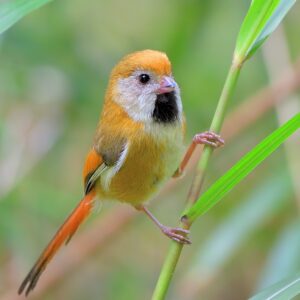 Golden Parrotbill
Golden Parrotbill
Day 12 We travel down the mountain, with birding stops along the way, to a lowland forest near Huben which is the best place to see the fabulous but rare Fairy Pitta which migrates here each spring. At the end of the afternoon, we arrive in the town of Douliu for a two night stay. Dinner and overnight at the Yunlin Gukeng Da-Hu Villa.
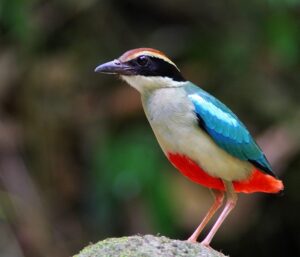 Fairy Pitta
Fairy Pitta
Day 13 We revisit the ‘Fairy Pitta forest’ where many other birds to look for include Greater Painted Snipe, Barred Buttonquail, Pacific Swallow, Yellow-bellied and Plain Prinias, Golden-headed Cisticola, White-rumped Shama and Oriental Magpie Robin. Dinner and overnight at the Yunlin Gukeng Da-Hu Villa.
Day 14 We head for the southwest coast, with a stop en route at the Jacana Ecological Park, a wetland with a variety of waterbirds including the extravagant Pheasant-tailed Jacana. From here we head to the coastal town of Budai for a two night stay at the harbourside Ocean Hotel.
 Pheasant-tailed Jacana
Pheasant-tailed Jacana
Day 15 We spend today exploring a chain of wetlands along the west coast near Budai. This is a birder’s paradise and another great place for photo-opportunities and one of the best sites for the rare Black-faced Spoonbill. We can also expect a wonderful variety of other waterbirds such as Baikal Teal, Falcated Duck, Intermediate Egret, Cinnamon Bittern, Ruddy-breasted Crake, Sacred Ibis, Greater and Lesser Sandplovers, Pacific Golden Plover, Great Knot, Asian Dowitcher, Far Eastern Curlew, Sharp-tailed, Terek, Marsh and Broad-billed Sandpipers, Red-necked and Long-toed Stints, Gull-billed and Bridled Terns and Saunders’s and Black-tailed Gulls. Eastern Marsh Harrier and Black-shouldered Kite are also possible along with Oriental Skylark and Vinous-throated Parrotbill. In the evenings, up to 20,000 Whiskered Terns come to roost near oyster farms, which is an amazing sight as the sun sets. Dinner and overnight at the Ocean Hotel.
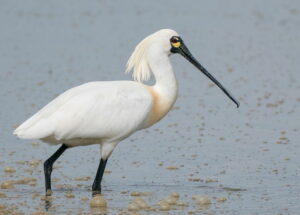 Black-faced Spoonbill
Black-faced Spoonbill
Day 16 Our travels continue south via Tainan, the oldest city and former capital of Taiwan, established by the Qing Dynasty in 1683. Continuing south, we reach Kenting National Park on the southernmost tip of the island. Surrounded by the sea on three sides, around 200 different birds have been seen here amid the impressive scenery including 26 different raptors like White-bellied Sea Eagle, Black-eared Kite, Oriental Honey Buzzard, Grey-faced Buzzard and Japanese Sparrowhawk. Other possibilities include Black-chinned Fruit Dove, Asian Emerald Dove, Whistling Green Pigeon, Azure-winged Magpie and Black-faced Bunting. Dinner and overnight at the Kenting Maya Guesthouse.
Day 17 This morning, we have a final visit to Kenting National Park, and in the afternoon we transfer to Zuoying railway station and take the high speed train (185 mph) back to Taipei International Airport with a journey time of just 90 minutes. We have a late evening flight with Turkish Airlines to Istanbul. Dinner and overnight in flight.
Day 18 We arrive in Istanbul at 04.50 and transfer to an onward flight to Birmingham, which arrives at 10am, after a memorable and productive tour of ‘The Beautiful Island’.
Cost £5530 Single supplement: £990 Full payment is required at the time of booking
What the price includes:
Return flights from Birmingham to Taipei, via Istanbul, with Turkish Airlines, fifteen nights’ full board en-suite accommodation, all transport in Taiwan, all reserve entry fees, complimentary Fieldguide to the Birds of Taiwan, field checklist and the services of your guides.
Additional information:
The flight time between Birmingham and Istanbul is about 4 hours and the flight time between Istanbul and Taipei is about 11 hours 45 minutes.
A visa is not required for British citizens to visit Taiwan.
It is advisable to be vaccinated against Hepatitis A. There is no risk of Malaria.
April is at the end of the cooler dry season when temperatures in Taipei, which is close to sea level, range from 20 – 23°C, although it is obviously cooler at higher altitudes. In April, Taipei receives about 3 inches of rain, which is roughly double the amount we get in the same month in the UK, and there is a 60% chance of rain each day.
We will be staying in seven good mid range accommodations, conveniently located near the birding areas.
We can expect to see around 200 bird species including all the endemics, with great photo-opportunities along the way.
 A birding group dinner in Taiwan
A birding group dinner in Taiwan
